Welcome to CounterTobacco.org’s “News and Research Roundup!” Each month we post a summary of the latest research, reports, and news stories on counteracting tobacco product sales and marketing at the point of sale (POS). Keeping up with what’s happening in the POS movement all across the country can help you choose policies and strategies that work best for your community. New research can help provide support for your work and evidence for the importance of the “War in the Store.” Have a story you don’t want us to miss? E-mail it to us!
New Research
Disparities and Pricing Policy
- Availability price, and promotions for cigarettes and non-cigarette tobacco products: an observational comparison of US Air Force bases with nearby tobacco retailers, 2016, Tobacco Control
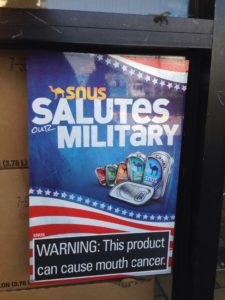 This study assessed both pricing and availability of tobacco products sold on air force bases and nearby off-base. Cigarette and smokeless tobacco use prevalences are both higher among active duty military members than among the general civilian population. The study found that cigarette prices were 11-12% cheaper overall at on-base retailers than at nearby off-base retailers. By brand, Newport Menthol cigarettes were $0.87 cheaper, Marlboro Reds were $0.80 cheaper, and the cheapest available pack was $0.54 cheaper on-base. For smokeless tobacco, Copenhagen was $0.65 cheaper on-base. This is despite a March 2017 Department of Defense policy that requires all military-priced tobacco products to match the prevailing local price in the community. On-base stores also had cigarette cartons available for purchase at all stores, whereas only 61% of off-base stores sold cartons. In addition, on-base stores were more likely to have price promotions for cigarettes and smokeless tobacco advertised inside the stores than nearby off-base stores.
This study assessed both pricing and availability of tobacco products sold on air force bases and nearby off-base. Cigarette and smokeless tobacco use prevalences are both higher among active duty military members than among the general civilian population. The study found that cigarette prices were 11-12% cheaper overall at on-base retailers than at nearby off-base retailers. By brand, Newport Menthol cigarettes were $0.87 cheaper, Marlboro Reds were $0.80 cheaper, and the cheapest available pack was $0.54 cheaper on-base. For smokeless tobacco, Copenhagen was $0.65 cheaper on-base. This is despite a March 2017 Department of Defense policy that requires all military-priced tobacco products to match the prevailing local price in the community. On-base stores also had cigarette cartons available for purchase at all stores, whereas only 61% of off-base stores sold cartons. In addition, on-base stores were more likely to have price promotions for cigarettes and smokeless tobacco advertised inside the stores than nearby off-base stores.
- A comprehensive examination of own- and cross-price elasticities of tobacco and nicotine replacement products in the U.S., Preventive Medicine
- Based on Neilsen store scanner data and three empirical models, this study found that demand for combustible tobacco products, except for cigars, was elastic in that for every 10% increase in price, sales decreased by 10%. Broken out by category, a 10% increase in price would result in:
- 15% decrease in demand for cigarettes
- 13% decrease in demand for cigarillos
- 17% decrease in demand for little cigars
- 14% decrease in demand for RYO loose tobacco
- 26% decrease in demand for pipe tobacco
- Demand for moist snuff was less elastic than demand for combustible tobacco products, while demand for e-cigarettes and NRT was more elastic. E-cigarettes and NRT also showed price elasticity where a 10% increase in price for e-cigarettes would reduce demand by 14% for reusable e-cigarettes and by 16% for disposable e-cigarettes. A 10% increase in price of NRT would reduce demand for patches by 14%, gum by 11%, and lozenges by 14%.
-
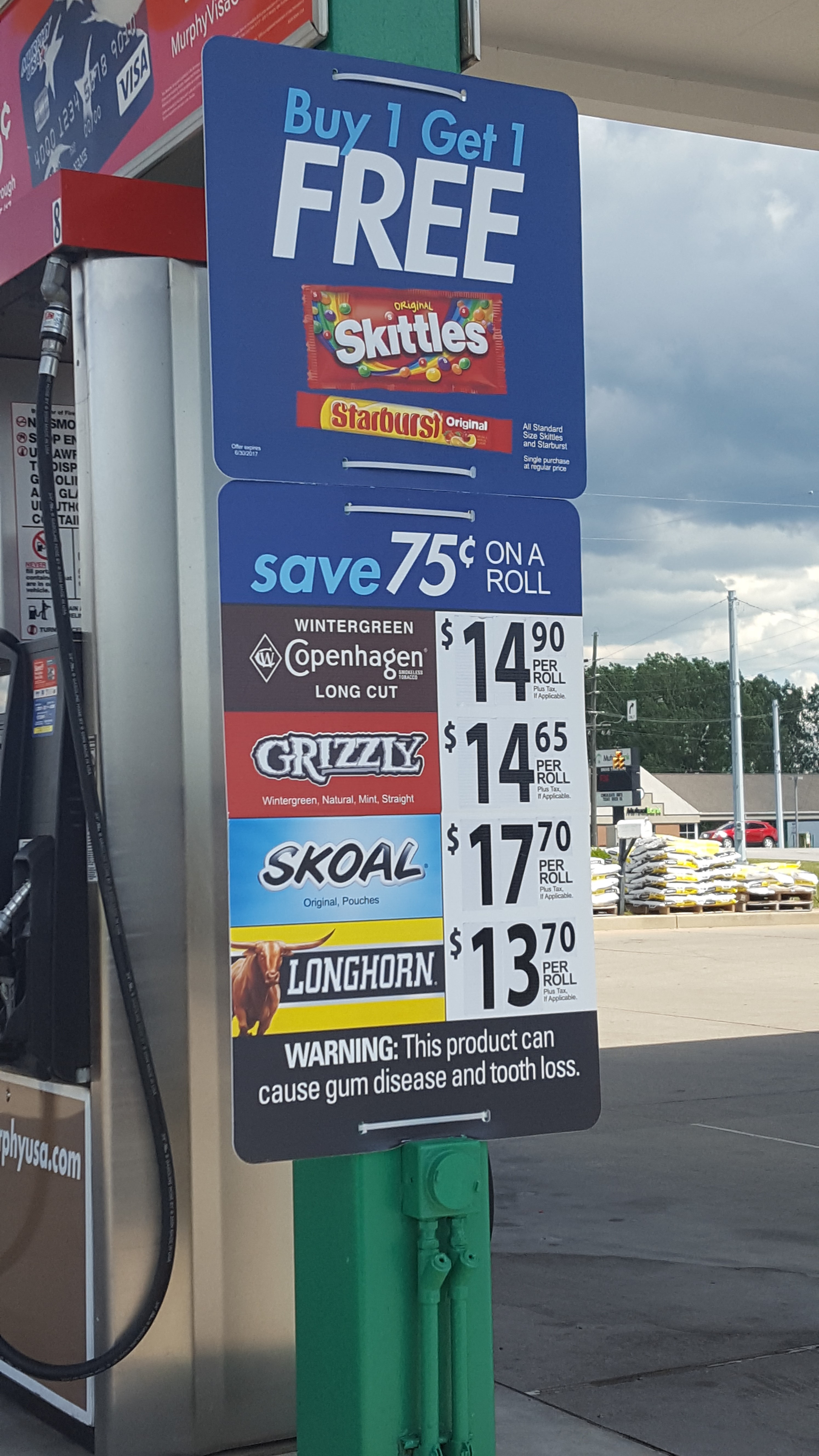
Smokeless Tobacco Roll Price Promotion Cross-product price elasticity models show that little cigars, RYO loose tobacco, pipe tobacco, and NRT lozenges may serve as substitute for cigarettes, with people purchasing more of them when cigarette prices go up. Other products also showed cross-product price elasticity with cigarettes, but with relationships that were not significant.
- Based on Neilsen store scanner data and three empirical models, this study found that demand for combustible tobacco products, except for cigars, was elastic in that for every 10% increase in price, sales decreased by 10%. Broken out by category, a 10% increase in price would result in:
- The role of travel distance and price promotions in tobacco product purchase quantity , Health & Place
- This study examining tobacco purchase patterns in urban and Appalachian rural areas of Ohio found that combustible tobacco users were more likely to purchase a greater quantity of tobacco if they lived farther away from a tobacco outlet and used a price promotion. Smokeless tobacco users were also more likely to purchase greater amount of snuff when they used price promotions. This study provides evidence that policies restricting the use of price promotions could impact the purchasing behavior of tobacco users in rural area that live farther away from tobacco outlets in addition to the expected impact from raising prices. It could also impact disparities currently seen with higher rates of cigarette and smokeless tobacco use in rural areas.
- Learn more about policies restricting the use of price promotions.
Flavored Tobacco Products
- A fMRI study on the impact of advertising for flavored e-cigarettes on susceptible young adults, Drug and Alcohol Dependence
- A group of 26 college-aged non-smoking adults who had tried an e-cigarettes and were susceptible to future e-cigarette use showed greater neural cue-reactivity in an fMRI when viewing ads for sweet or fruity flavored e-cigarette compared to when viewing ads for tobacco-flavored products. Participants also showed greater preference for sweet or fruity-flavored product. In addition, the participants were less likely to pay visual attention to or recall health warnings on packages for sweet or fruity flavored products.
- Alcohol-flavoured tobacco products, Tobacco Control
- An online search of tobacco product lines found widespread availability of alcohol-flavored tobacco products. Researchers identified 48 types of alcohol-flavored tobacco products marketed by 409 different tobacco brands. There were a range of flavors, including mixed drinks, spirits, liqueurs, and wine/beer. Learn more about flavored tobacco products.
- The effort of cigarillo packaging elements on young adult perceptions of product flavor, taste, smell, and appeal, PLOS ONE
 This web-based experiment with 2,664 young adults found that pink and purple packs of cigarillos were more likely to be perceived as flavored than packs with no color, and youth also rated them more favorably on taste, smell, and appeal. Packs with any flavor descriptor (including Grape, Wine, Sweet, or Tropical) were more likely to be perceived as flavored than packs with no flavor descriptors. When the packaging included a health warning, participants rated them as less favorable on taste and smell, but still perceived them to be flavored if they were pink or purple.
This web-based experiment with 2,664 young adults found that pink and purple packs of cigarillos were more likely to be perceived as flavored than packs with no color, and youth also rated them more favorably on taste, smell, and appeal. Packs with any flavor descriptor (including Grape, Wine, Sweet, or Tropical) were more likely to be perceived as flavored than packs with no flavor descriptors. When the packaging included a health warning, participants rated them as less favorable on taste and smell, but still perceived them to be flavored if they were pink or purple.- This study provides evidence that policymakers should consider a wide range of both overt and ambiguous descriptors that connote a flavor when implementing flavor restrictions. In addition, researchers note that these findings provide evidence that supports eliminating colors from cigarillo product packaging if the colors imply a flavor or lead the consumer to believe the product is less harmful.
- News Story: Cigarillos packaging can influence product perception, study finds, UNC Lineberger News
E-cigarettes
- Transitions in electronic cigarette use among adults in the Population Assessment of Tobacco and Health (PATH) Study, Waves 1 and 2 (2013-2015), Tobacco Control
- This analysis of data from the Population Assessment of Tobacco and Health Study found that e-cigarette use patterns were highly variable over the course of a year. Of participants who were e-cigarette users at Wave 1, about half (48.8%) discontinued use at Wave 2, 44.5% maintained dual use, 43.5% discontinued e-cigarette use and maintained cigarette use, and 12.1% discontinued cigarette use (5.1% still used e-cigarettes, while 7% quit using both products). Among those use used both e-cigarettes and cigarettes at Wave 1, those who were daily e-cigarette users were more likely to have stopped smoking at Wave 2.
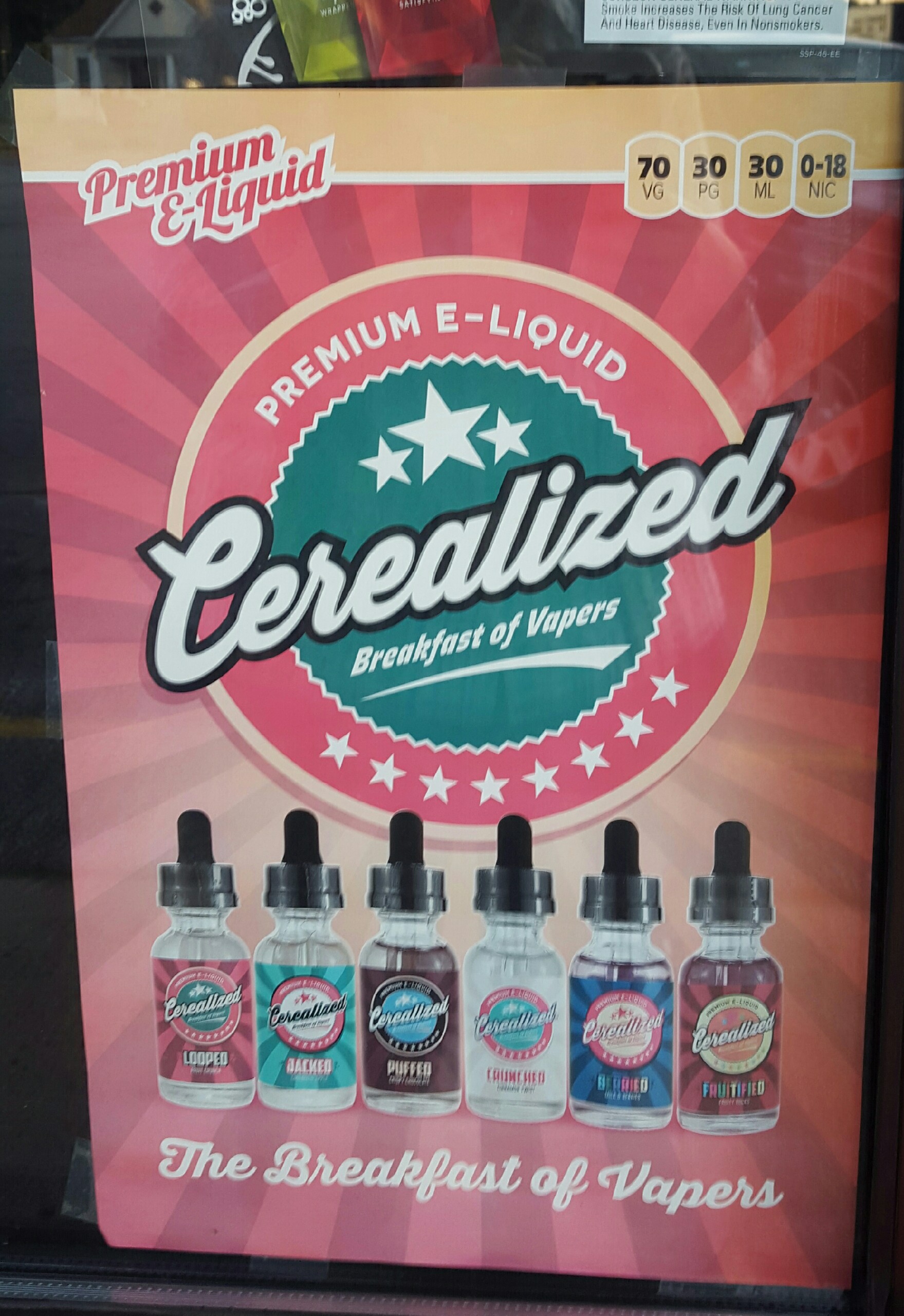
E-liquid advertisement
- This analysis of data from the Population Assessment of Tobacco and Health Study found that e-cigarette use patterns were highly variable over the course of a year. Of participants who were e-cigarette users at Wave 1, about half (48.8%) discontinued use at Wave 2, 44.5% maintained dual use, 43.5% discontinued e-cigarette use and maintained cigarette use, and 12.1% discontinued cigarette use (5.1% still used e-cigarettes, while 7% quit using both products). Among those use used both e-cigarettes and cigarettes at Wave 1, those who were daily e-cigarette users were more likely to have stopped smoking at Wave 2.
- Socioeconomic status and adolescent e-cigarette use: The mediating role of e-cigarette advertisement exposure, Preventive Medicine
- This study found that adolescents with higher socioeconomic status are exposed to greater levels of e-cigarette advertising (through TV, radio, billboards, magazines, at local gas stations or convenience stores, vape shops, mall kiosks, tobacco shops, or on social media), which in turn, makes them more likely to use e-cigarettes more frequently. Learn more about e-cigarettes at the point of sale.
- E-cigarette openness, curiosity, harm perceptions and advertising exposure among U.S. middle and high school students, Preventive Medicine
- Data from the 2015 National Youth Tobacco Survey show that youth who have never used tobacco products but report high exposure to e-cigarette advertising were more likely to be open to e-cigarette use and to be highly curious about e-cigarettes compared to those exposed to lower levels of e-cigarette advertising.
Other
- Tobacco outlet density and tobacco knowledge, beliefs, purchasing behaviors and price among adolescents in Scotland, Social Science & Medicine
- The study found that youth ages 13-15 years old who had never smoked but live in an area with greater tobacco retailer density could name more cigarette brands than youth who lived in an area with lower tobacco retailer density. This indicates that tobacco retailer density increases awareness of tobacco products. Learn more about tobacco retailer density and policies that can affect it.
- Public versus internal conceptions of addiction: An analysis of internal Philip Morris documents, PLOS Medicine
- While Philip Morris, along with other tobacco companies, long denied that nicotine was addictive, they were the first tobacco company to publicly admit it after the 1998 Master Settlement Agreement. They continue to maintain the nicotine is the primary driver of addiction today as they attempt to shift to other nicotine delivery forms (e.g. e-cigarettes). However, tobacco industry documents from the mid-1990s through at least 2006 show that Philip Morris’s internal models of addiction include not only nicotine, but also include psychological, social, and environmental factors (e.g. advertising, cost, smoking restrictions), which are shaped by tobacco industry activity (e.g. marketing, lobbying, litigation) as drivers of cigarette use and addiction. The researchers conclude that recognizing this biopsychosocial model that incorporates the impact of tobacco industry activities on tobacco use and addiction would also support more comprehensive strategies to reduce tobacco use and tobacco disparities.
New Reports
- Menthol Cigarettes: Attitudes, Beliefs and Policies, Truth Initiative
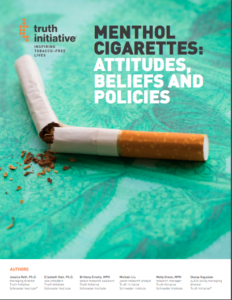
- This study showed the prevalence of a number of misconceptions around menthol in cigarettes. For example, 41% of participants incorrectly believed that there were health benefits associated with menthol cigarettes, 60% incorrectly thought that menthol makes it easier to quit smoking, and only 36% knew that menthol cigarettes were advertised in low-income and minority neighborhoods. African Americans were more likely to hold these misconceptions. The study also showed high support for banning menthol, with 60% in support of a ban and 64% agreeing that such a ban would improve the health of people in the U.S. However, white participants were more likely to support a ban or agree that a ban would improve the health of people in the U.S. than African-American participants. There were also racial differences in predicted response to a menthol ban, with more African-American menthol smokers reporting that they would quit if such a ban existed, while more white menthol smokers reported they would switch to non-menthol cigarettes.
Industry News
- 3 Factors Driving the Cigarette and E-Cig Markets, CSP Daily News
- Circle K Tests Tobacco Club, CSP Daily News
- How to Capture Smoking Cessation Sales, CSP Daily News
POS Policy in the Media
Federal
- F.D.A. Cracks Down on ‘Juuling’ Among Teenagers, New York Times
- Tobacco manufacturers reach agreement on next phase of corrective statement rollout, Winston-Salem Journal
- Vaping Products That Look Like Juice Boxes and Candy Are Target of Crackdown, New York Times
Tobacco 21
- Massachusetts may raise age to purchase tobacco, Metro West Daily
- Hawaii lacks enforcement for underage e-cigarette sales, KITV
- Illinois Senate votes to raise age to buy tobacco to 21, State Journal-Register
- Peoria raises age to buy tobacco to 21, Peoria Journal Star
- Editorial: Raise the age to buy tobacco and vaping products, Chicago Tribune
- Advocates seeking to raise age for cigarette sales in Cincinnati, com
- New Castle prohibits sales of tobacco products to people under 21, Lohud
- Minneapolis committee approves Tobacco 21 ordinance, Fox 9
- Ulster County Legislature OKs raising minimum age for buying tobacco to 21, Daily Freeman
- Shoreview raises age to buy tobacco to 21, joining Bloomington, Edina and other cities, Twin Cities Pioneer Press
Menthol and Other Flavored Tobacco Products
-
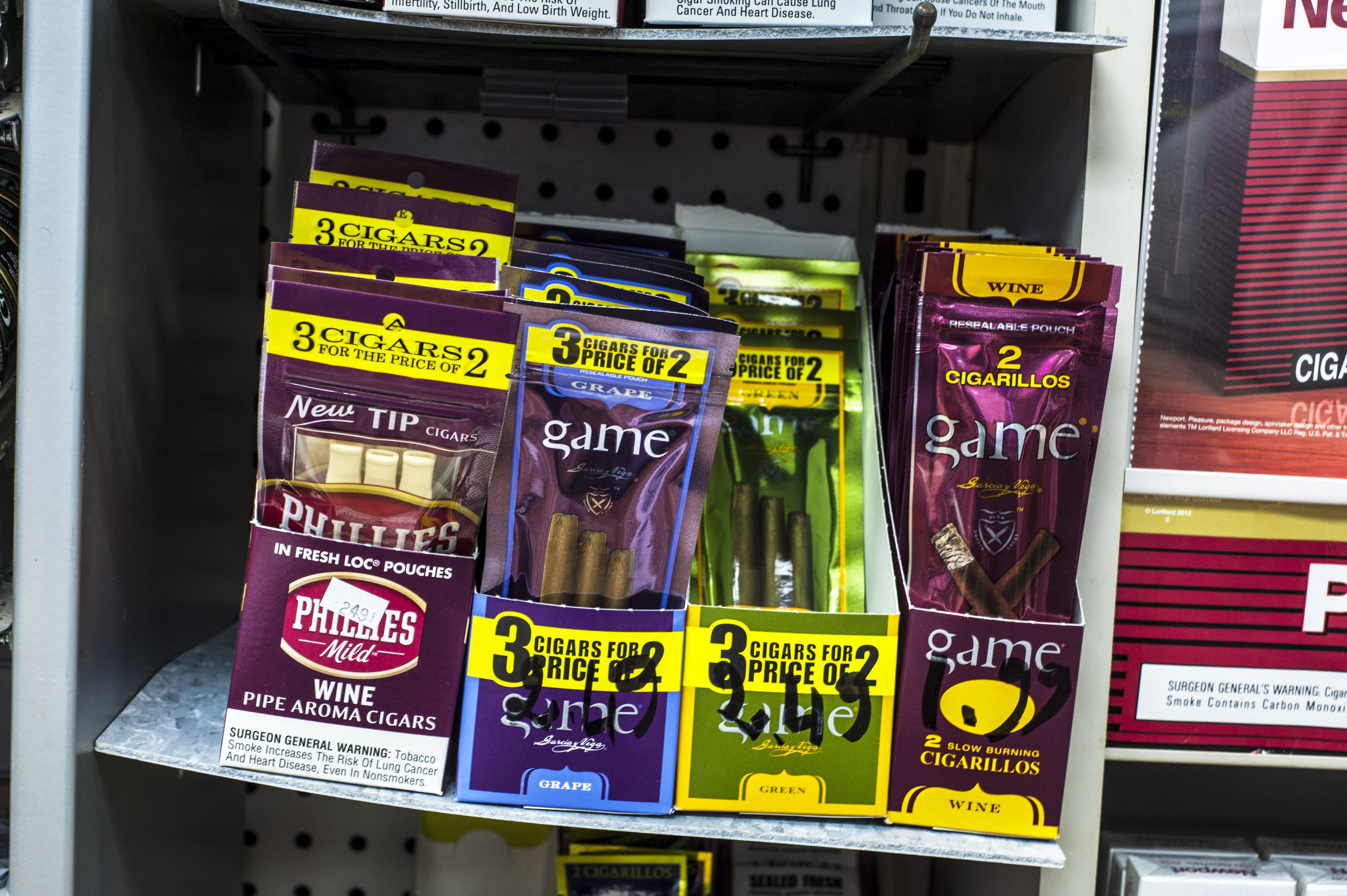
Flavored tobacco products Mono County enacts new tobacco ordinances, Sierra Wave
- Local teens fight Big Tobacco’s influence, Gloucester Times
- Danvers Board of Health passes ban on sale of flavored tobacco, Wicked Local Danvers
- San Francisco to Vote on Ban of Flavored E-Cigarettes and Tobacco, NPR
- Saving San Francisco’s ban on candy-flavored tobacco products, San Francisco Examiner
- Flavored Tobacco Targeted at Milwaukee Youth Drives Lifelong Addiction for Profit, Milwaukee Independent
- California points out flavor deception for kids in the tobacco industry’s new products, The Drum
- Worcester bans flavored tobacco in retail stores, Worcester Business Journal
- Council to consider restricting sale of flavored tobacco products, Philadelphia Tribune
- Anti-tobacco advocates want Philly to ban sales of all flavored smoking products, Philadelphia Inquirer
- Falcon Heights Raises Tobacco Buying Age To 21, Restricts Sale of Flavored Tobacco, CBS Minnesota
Other
- Albany County Legislature Passes Measure Banning Pharmacy Tobacco Sales, WAMC
- Teens work with Napa market to discourage soda, tobacco and alcohol use by fellow teens, Napa Valley Register
- Philip Morris device knows a lot about your smoking habit, Reuters
Find more stories in last month’s News and Research Roundup.
Know of a story that we missed? Email us, and we’ll be sure to include it in next month’s roundup!


